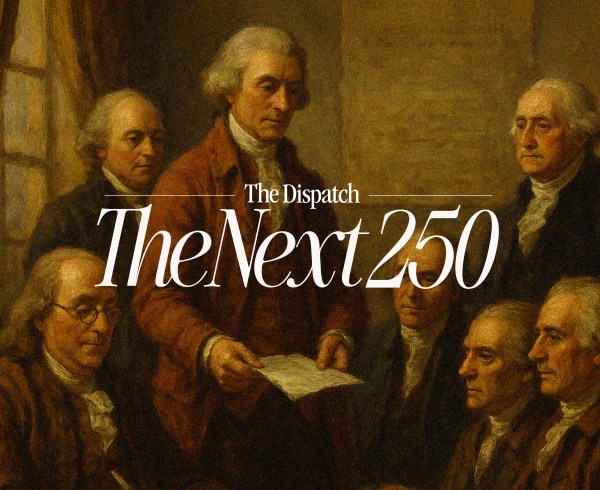Happy Wednesday! There’s nothing like the love between a man and his dog—especially when that man is President Joe Biden and his dog is a German shepherd named Commander who has reportedly bitten people no fewer than 10 times in four months, sending one Secret Service agent to the hospital.
Quick Hits: Today’s Top Stories
- A federal judge in California on Tuesday blocked the Biden administration’s policy barring from asylum most migrants who cross the border illegally without having first filed for asylum in any country through which they traveled on their way to the United States. District Judge Jon Tigar—an Obama appointee who struck down a similar measure under Trump—ruled that the so-called “transit ban” violates the law by penalizing asylum seekers for crossing the border between entry points and requiring many to apply for asylum in unsafe third countries. Tigar delayed the effect of his decision for two weeks, and the Department of Justice has filed a notice of appeal.
- The Biden administration announced Tuesday it would send additional military aid to Ukraine to replenish the country’s dwindling stocks as the counter-offensive continues. The $400 million package—drawn from existing Defense Department stockpiles—will include additional Patriot missiles, HIMARS rocket launchers, and Stinger anti-aircraft munitions, plus additional artillery and mortar rounds and 32 more Stryker armored personnel carriers, among other items.
- The Department of Education Monday opened a civil rights investigation into Harvard University’s legacy admissions policy. The investigation responds to a complaint filed by three legal groups earlier this month alleging the school’s practice of giving preference to the children of disproportionately white alumni illegally discriminates against black, Hispanic, and Asian applicants who are otherwise more qualified. The move follows the Supreme Court decision last month striking down Harvard’s consideration of race in admissions.
- UPS and the Teamsters union reached a tentative agreement Tuesday to avoid a strike of roughly 300,000 drivers and package sorters that had been slated to begin August 1. Pending employee ratification, the deal will hike starting part-time wages from about $16.20 to $21 an hour and give union members a raise of $7.50 over the next five years. The agreement would also require UPS to put air conditioning in new delivery vans.
- A federal judge in D.C. vacated the 2017 desertion conviction and dishonorable discharge of former Army Sergeant Bowe Bergdahl, who walked off of a base in Afghanistan in 2009. He was captured by the Taliban and held for five years before being freed in a prisoner exchange in 2014. The judge argued Bergdahl did not receive a fair trial because the judge in the case failed to disclose he was concurrently applying for a job in former President Donald Trump’s Justice Department—Trump had called Bergdahl a traitor and suggested he should be executed. Bergdahl may now face a second trial before a different judge.
- The S&P CoreLogic Case-Shiller National Home Price Index recorded a 0.5 percent year-over-year drop in home prices in May—up from a 0.1 percent decline in April and the largest such drop since 2012 as mortgage rates have stayed high, cooling demand, after 2022’s fast interest rate hikes. House prices rose a seasonally adjusted 0.7 percent month-over-month in May, however, the third straight month of increase.
- Ron DeSantis’ presidential campaign confirmed yesterday dozens of staffers have been laid off in recent weeks as concerns over the organization’s finances mount. Among the layoffs was Nate Hochman, a onetime Dispatch intern and former National Review reporter who campaign sources told Axios was responsible for the creation of a recent pro-DeSantis video that contained neo-Nazi imagery.
- Chinese state media reported Tuesday that Foreign Minister Qin Gang—who hadn’t been seen publicly in a month—has been removed from office after only seven months in the role. Qin’s unexplained absence had disrupted diplomatic engagements with China, and official reports offered no reason for the ouster of an official previously seen as close to Chinese leader Xi Jinping. His predecessor Wang Yi will return to the role of foreign minister.
- U.S. Air Force officials said a Russian fighter jet flew within several meters of a U.S. Reaper drone completing a mission in Syria Sunday and dropped flares, damaging the drone’s propeller and forcing it back to base. Sunday’s incident was the latest in a recent string of risky Russian maneuvers interfering with U.S. operations in the region—Chairman of the Joint Chiefs of Staff Gen. Mark Milley said last week U.S. analysts are assessing possible reasons for the uptick.
- Israeli Defense Forces killed three Palestinian members of Hamas in the occupied West Bank Tuesday. The IDF said the militants had fired at Israeli troops from a black vehicle and that Israeli security forces confiscated M-16 rifles and other military equipment from the militants’ car.
We May Have Started the Fire
We’re pretty sure the U.S. Forest Service wasn’t trying to join the Barbenheimer buzz this week, but it did so anyway—just as Christopher Nolan released a film about building the first atomic bomb at Los Alamos, New Mexico, the Forest Service admitted its own planned burn started a forest fire last year that almost scorched that very town.
The United States has so far had a comparatively mild wildfire season, but smoke drifting down from Canadian wildfires has shrouded city skies with a yellow-orange haze. Among this week’s casualties are Chicago and Minneapolis—and spectacular Door County, Wisconsin. The smoke has refocused attention on managing fires, but as the Forest Service’s blunder demonstrates, that’s a tricky business in an age of heat waves exacerbated by climate change.
The smoke drifting south into the U.S. is courtesy of Canada’s hellish summer. Our neighbors to the north are in the midst of the worst wildfire season on record in the boreal forests—a broad section of woodlands that spans the country. The previous annual burn record was 18 million acres. This year, almost 30 million acres have already burned with at least a month still left in the peak of the fire season—as of yesterday, more than 1,000 active fires raged across the country with more than 600 burning out of control.
Most of Canada’s fires aren’t menacing cities, but their isolation from population centers makes them extra hard to combat, as firefighters struggle to get close. “In Canada, the boreal forest is this fairly remote forest, fairly contiguous,” Robert Scheller, a professor of forestry and environmental resources at North Carolina State University, tells TMD. “There’s not a ton of roads and infrastructure, which means there’s not a lot that forest management can do about wildfires.”
Forest management and climate researchers generally agree that climate change makes worse burns more likely—though it’s not the sole cause of wildfires, which long predate current warming temperatures and are a natural part of some ecosystems’ life cycles. “Wildfire always results from multiple ingredients coming together,” Noah Diffenbaugh, a professor of earth system science at Stanford University, tells TMD. “Climate and weather conditions are a key ingredient, but they’re not the only ingredient. But we know that overall, global warming has been increasing the risk of climate weather conditions that are conducive to wildfire.” Some Canadian political leaders have emphasized that campfires and lightning strikes caused these fires—but weather conditions largely determine how bad fires will be.
Higher temperatures thanks to climate change can make heat waves and droughts worse and more frequent than they otherwise might be, which leaves the brush, shrubs, and dead wood that fuel wildfires drier, “creating perfect conditions for really hot, really large wildfires,” Scheller tells TMD.
This isn’t just a problem for North America. Though it’s too soon to measure how global acreage burned compares to previous years, several countries in the Mediterranean and North Africa are suffering heat waves and accompanying wildfires. Blazes on the Greek island of Rhodes forced 19,000 residents and tourists to flee, the largest fire evacuation in the country’s history. Other fires are tearing through Italy, Spain, and Algeria—where 34 people have died.
Meanwhile, the U.S. has witnessed successive years of severe wildfires—more than 10 million acres of land burned in 2015, 2017, and 2020, up from between 1.3 and 6 million acres in the 1990s. This year, the country is experiencing a relatively mild fire season thanks to especially heavy winter snowfall. “The reason we’re not seeing a lot of fires right now, in the West, is they just had an incredible snowpack this year,” Scheller tells TMD. The snowmelt has kept fires at bay—though more fires could crop up as the snowpack waters recede in the early fall.
Compared to Canada, America’s population density puts more people and property at risk from wildfires—but it also makes management easier. California, for example, has many more roads, giving crews access to run prescribed burns—planned and controlled smaller-scale fires that clear out dead undergrowth. Forest management researchers want more of these burns in California. “That’s an area where aggressive management could shift the fire regime, could help in the long term,” Scheller tells TMD.
For decades, the Forest Service instead prioritized trying to stop all wildfires as soon as possible—all fires are bad fires, the thinking went, and the best way to avoid an accident like the fire that nearly swept Los Alamos is to skip the controlled burn altogether. But such overly aggressive fire suppression prevented more limited burnoffs of prime wildfire fuel, creating “choked forests” that act like tinderboxes for mega-fires. When a lightning strike or stray campfire inevitably does start a fire—especially during a drought—the resulting super-hot blaze devastates forests that could survive smaller blazes.
As a result, brutal wildfire seasons in recent years have ripped through forests—which are already contending with other troubles. “The forests as we know them in California and across the West, they’re dying,” explained Eli Ilano, the supervisor for the Tahoe National Forest—a forest plagued by excess dead trees. “They’re being destroyed through fire. They’re dying from drought, disease, and insects. They’re dying at a pace that we’re having trouble keeping up with.”
Recognizing the problem, U.S. policymakers are pushing for better forest management. In 2022, the Forest Service released a 10-year plan for significantly increasing “fuels and forest health treatments” including prescribed burns, logging and tree thinning, and clearing forest floors of dead materials that fuel blazes. The strategy will cost an estimated $50 billion to execute and has yet to be fully funded—the Bipartisan Infrastructure Law and the Inflation Reduction Act provided almost $5 billion for the effort. Yet, more than a year and a half into the new strategy, the forest service has struggled to make progress on clearing out forest undergrowth. Secretary of Agriculture Tom Vilsack has cited difficulty in hiring new staff as one factor hampering the effort.
Short-term solutions won’t be enough. “We’re going to have to make investments for the next many decades into the future in helping our forests adapt to climate change,” Scheller argues—including not just prescribed burns but also planting fire and drought-resistant species of trees. “This isn’t going to be a one-and-done.”
The warmer the climate gets, the bigger the challenge may be. “To be effective, adaptation is going to have to not just catch up with climate change that’s already happened,” Diffenbaugh tells TMD, “but also leapfrog ahead to the climate change that will occur in the future.”
Pushing back on PEPFAR
Like any self-respecting former president, George W. Bush makes every effort to avoid returning to Washington, D.C., too often—you don’t want to look desperate for the old digs. But in February, Bush made a swamp visit to advocate for the survival of a policy he said someone once mistook for a toothpaste brand. “It takes a lot to get me back to Washington—and PEPFAR is it,” he said.
The President’s Emergency Plan for AIDS Relief—PEPFAR—has bipartisan support and a track record of success. But conservative groups and lawmakers concerned about supporting abortion want the Biden administration to ensure foreign contractors that also promote abortion access don’t get PEPFAR money—and they’re opposing a multiyear reauthorization of the program until the administration agrees.
Since its introduction under Bush in 2003, PEPFAR has put more than $100 billion toward HIV-AIDS prevention and treatment. It’s saved an estimated 25 million lives with antiretroviral treatments, testing, and care for children vulnerable to the disease—contributing to rising life expectancies in several African nations.
“We forget that, once upon a time, HIV/AIDS was the worst pandemic in human history,” says David Fidler, a senior fellow for global health and cybersecurity at the Council on Foreign Relations. “And PEPFAR is a seminal reason why, today, we don’t have to talk about HIV/AIDS as that type of catastrophic emergency.”
Plenty of lawmakers are happy to rubber stamp PEPFAR’s reauthorization, but one key player is kicking up a fuss: Rep. Chris Smith, a Republican from New Jersey who chairs the House Foreign Affairs subcommittee responsible for overseeing the reauthorization. Smith wrote the program’s last reauthorization bill in 2018 and, until recently, supported extending it again. He’s retracted his support for the planned five-year reauthorization, arguing the Biden administration is slipping support for abortion into PEPFAR.
The program doesn’t fund or promote abortions—that would violate laws in both the U.S. and many of the African countries where PEPFAR operates—but some PEPFAR contractors use money from other sources to fund abortions or advocate for abortion access. To prevent this, the Trump administration instituted the “Protecting Life in Global Health Assistance” policy—otherwise known as the “Mexico City policy”—which bars any foreign organizations that perform or promote abortion from receiving taxpayer dollars.
Biden dropped this measure in 2021, and Smith—backed by activists and conservative research groups opposed to abortion—wants it reinstated. Activist groups opposed to abortion were also upset by a September State Department memo vowing to “reimagine” PEPFAR and “strengthen coordination” with other developmental programs addressing “sexual and reproductive health and rights, gender equality, LGBTQI+, and human rights.”
For some groups like the conservative evangelical Family Research Council (FRC), these efforts seem like code for quietly promoting abortion access. “Under the Biden administration, there have been several changes to the way PEPFAR is being approached that give us pro-life and pro-family people concerns,” Travis Weber, vice president for policy and government affairs at FRC, tells TMD.
The State Department memo now includes a footnote specifying “the program does not under any circumstances provide support for abortion services,” but that isn’t enough. Anti-abortion groups including Susan B. Anthony Pro-Life America and Heritage Action have threatened that voting for a five-year PEPFAR reauthorization will cause a mark against a lawmaker on their scorecards, used to signal conservative bona fides to voters. In a letter to Rep. Michael McCaul, the chairman of the House Foreign Affairs Committee, and Sen. Jim Risch, the ranking member on the Senate Foreign Relations Committee, leaders of more than two dozen anti-abortion groups urged the Republican leaders to make sure the Mexico City policy applies to PEPFAR.
Both Risch and McCaul have signaled their support for reauthorizing PEPFAR. “I am working with my colleagues on both sides of the aisle in the House and the Senate to reauthorize this vital program that is responsible for saving 25 million lives worldwide over the last 20 years,” McCaul said in a statement to TMD. In the House, it’s not clear whether others will join Smith’s fight—Republican members of his subcommittee didn’t respond to TMD’s requests for comment about whether they support the measure.
One source close to Smith tells TMD a multiyear reauthorization is off the table until the Biden administration is willing to discuss reinstating the Mexico City policy. Smith has instead proposed extending PEPFAR funding on a year-to-year basis through the appropriations process—a step that could degrade the program’s stability by making fights like this one more frequent. And new amendments added to the Fiscal Year 2024 State, Foreign Operations, and Related Programs Appropriations Act would tighten oversight of organizations that receive PEPFAR funding, strengthening provisions already in place to prevent taxpayer dollars from subsidizing abortions abroad.
If the reauthorization fails, PEPFAR won’t immediately cease operations, as the program is largely carried out under permanent legal authorities, and Congress can still set aside funds for it during the normal appropriations process. But some lawmakers worry the U.S. would be undermining a key foreign policy success. “The PEPFAR program remains one of our most potent soft power assets,” 75 members of Congress wrote Thursday in a letter to Secretary of State Antony Blinken and Global AIDS Coordinator John Nkengasong. Their statement followed a similar letter of support last month from a bipartisan group of 20 senators.
Fidler says while he doesn’t see PEPFAR as a consequential foreign policy tool, failing to reauthorize it would nevertheless make the U.S. vulnerable to criticism. “If reauthorization doesn’t happen, you will see geopolitical adversaries of the United States using that as a way to beat the United States over the head,” he tells TMD. “Even though China has never done anything like this in global health, they won’t miss an opportunity to do that.”
Worth Your Time
- In a piece for The Atlantic, Russell Moore says the American evangelical church is in crisis—and faced with a choice between the pursuit of nostalgia or revival. “Some evangelical Christians have confused ‘revival’ with a return to a mythical golden age,” he writes. “A generation ago, one evangelical leader said that the goal of the religious right should be 1950s America, just without the sexism and racism. Today, even those qualifications are evaporating. Nostalgia—especially of the sort wielded by demagogues and authoritarians—cannot protect religious faith, because it uses religion as a tool for worldly ends, leaving a spiritual void. The Christian church still needs an organic movement of people reminding the rest of us that there’s hope for personal transformation, for the kind of crisis that leads to grace. In a country exhausted by the quest to make America great again, perhaps what we need is to make evangelicalism born again. And, in the end, that’s not a strategy. It’s a prayer.”
- Country singer Jason Aldean should take a look at some crime statistics, Jim Geraghty argues in National Review. Aldean’s controversial new song, “Try That in a Small Town,” is “an emotionally satisfying oversimplification,” he writes. “As for the contention that small towns are safe and harmonious, and big cities are dangerous, violent, and chaotic, … It really depends upon the small town and big city that you’re comparing. Unsurprisingly, a country as large and diverse as the U.S. has small towns that are safe, and small towns that have high levels of violent crime. Ironically, the city with the highest rate of violent crime per 1,000 residents is … Bessimer, Ala., population 26,019. That city clocks in at 33.1 violent crimes per 1,000 residents, while the infamous New York City clocks in at 5.21 violent crimes per 1,000 residents.” Aldean implicitly suggesting city dwellers don’t take care of their own “has a bit of a whiff of victim-blaming,” Geraghty argues. “There are tens of millions of decent, law-abiding American citizens living in big cities. They are not enduring high crime rates because they aren’t ‘taking care of their own.’ They are generally being failed by local elected officials, ideologically driven prosecutors, and police forces that are variously undermanned, underfunded, facing recruitment problems, or attempting to overcome longstanding trust issues and past scandals.”
Presented Without Comment
CNN: It’s so hot in Arizona, doctors are treating a spike of patients who were burned by falling on the ground
Also Presented Without Comment
New York Times: Trump to return ancient coins and lamps to Israel’s antiquities agency
Toeing the Company Line
- What’s going on with the insurance market? Will deepfakes take over political ads? Is the DeSantis campaign in real trouble? Kevin was joined by Esther, Grayson, Drucker, and Mike, to discuss all that and more on last night’s Dispatch Live (🔒). Members who missed the conversation can catch a rerun—either video or audio-only—by clicking here.
- In the newsletters: In Uphill, Price covers lawmakers’ efforts to fund the government before the looming September deadline and Nick questions (🔒) the logic of Mitt Romney’s appeal to GOP donors.
- On the podcasts: What happens when technology can read your mind? On The Remnant, Nita Farahany, a professor at Duke Law School, joins Jonah to discuss her new book, The Battle for Your Brain: Defending the Right to Think Freely in the Age of Neurotechnology.
- On the site: Kevin argues the U.S. should punish Iran for aiding Russia in Ukraine and Gary Schmitt breaks down a report on intelligence failures around January 6, 2021.
Let Us Know
Do you live in an area affected by the smoke from Canadian forest fires? Has it caused health concerns or forced you to change any plans?









Please note that we at The Dispatch hold ourselves, our work, and our commenters to a higher standard than other places on the internet. We welcome comments that foster genuine debate or discussion—including comments critical of us or our work—but responses that include ad hominem attacks on fellow Dispatch members or are intended to stoke fear and anger may be moderated.
With your membership, you only have the ability to comment on The Morning Dispatch articles. Consider upgrading to join the conversation everywhere.